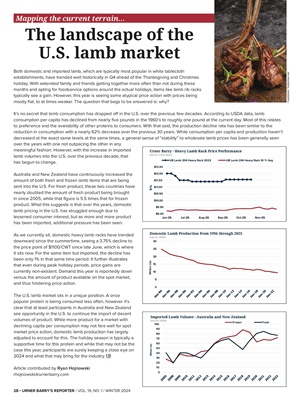
28 • URNER BARRY'S REPORTER / VOL. 19, NO. 1 / WINTER 2024
The landscape of the
U.S. lamb market
Both domestic and imported lamb, which are typically most popular in white tablecloth
establishments, have trended well historically in Q4 ahead of the Thanksgiving and Christmas
holiday. With extended family and friends getting together more often than not during these
months and opting for foodservice options around the actual holidays, items like lamb rib racks
typically see a gain. However, this year is seeing some atypical price action with prices being
mostly flat, to at times weaker. The question that begs to be answered is: why?
It's no secret that lamb consumption has dropped off in the U.S. over the previous few decades. According to USDA data, lamb
consumption per capita has declined from nearly five pounds in the 1960's to roughly one pound at the current day. Most of this relates
to preference and the availability of other proteins to consumers. With that said, the production decline rate has been similar to the
reduction in consumption with a nearly 62% decrease over the previous 30 years. While consumption per capita and production haven't
decreased at the exact same levels at the same times, a general sense of "stability" to wholesale lamb prices has been generally seen
over the years with one not outpacing the other in any
meaningful fashion. However, with the increase in imported
lamb volumes into the U.S. over the previous decade, that
has begun to change.
Australia and New Zealand have continuously increased the
amount of both fresh and frozen lamb items that are being
sent into the U.S. For fresh product, these two countries have
nearly doubled the amount of fresh product being brought
in since 2005, while that figure is 5.5 times that for frozen
product. What this suggests is that over the years, domestic
lamb pricing in the U.S. has struggled enough due to
lessened consumer interest, but as more and more product
has been imported, additional pressure has been seen.
As we currently sit, domestic heavy lamb racks have trended
downward since the summertime, seeing a 3.75% decline to
the price point of $1100/CWT since late June, which is where
it sits now. For the same item but imported, the decline has
been only 1% in that same time period. It further illustrates
that even during peak holiday periods, price gains are
currently non-existent. Demand this year is reportedly down
versus the amount of product available on the spot market,
and thus hindering price action.
The U.S. lamb market sits in a unique position. A once
popular protein is being consumed less often, however it's
clear that at least participants in Australia and New Zealand
see opportunity in the U.S. to continue the import of decent
volumes of product. While more product for a market with
declining capita per consumption may not fare well for spot
market price action, domestic lamb production has largely
adjusted to account for this. The holiday season is typically a
supportive time for this protein and while that may not be the
case this year, participants are surely keeping a close eye on
2024 and what that may bring for the industry.
Article contributed by Ryan Hojnowski
rhojnowski@urnerbarry.com
Mapping the current terrain…
$9.00
$9.50
$10.00
$10.50
$11.00
$11.50
$12.00
$12.50
Jun-26 Jul-26 Aug-26 Sep-26 Oct-26 Nov-26
Urner Barry - Heavy Lamb Rack Price Performance
Source: Urner Barry
UB Lamb 204 Heavy Rack 2023 UB Lamb 204 Heavy Rack 10 Yr Avg
$/lb.
0
5
10
15
20
25
30
Million Lbs
Domestic Lamb Production from 1994 through 2023
Source: USDA
0
10
20
30
40
50
60
70
80
90
100
Million Lbs
Imported Lamb Volume - Australia and New Zealand
Source: USDA
Frozen Fresh
©sutulastock / Shutterstock.com